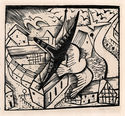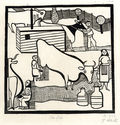
19th, 20th & 21st Century Fine Prints
707-546-7352 · fax 707-546-7924 · web: www.annexgalleries.com · email: artannex@aol.com
Gerhard Marcks Biography
Gerhard Marcks
German
1889–1981
Biography
Gerhard Marcks was born on February 18, 1889 in Berlin, Germany. Marcks was educated in the atelier of the sculptor Richard Scheibe (1879-1964); where he learned to sculpt animals using terra cotta. He served in World War I between 1914 and 1915.
Upon his return from the war he adopted a more Expressionist approach to his work, rendering human figures with a simplified angularity that recalls Gothic sculpture. At the Bauhaus in 1919 Marcks discovered the technique of woodcutting. In 1920 he was appointed to run the ceramics workshop at the Weimar Bauhaus where his focus was hand-painted pottery. American born Lyonel Feininger ran the Bauhaus printmaking workshop and encouraged him to explore woodcut as a primary medium.
To Marcks, three aesthetic choices were important. First of all, he wanted to experiment freely with his work as a teacher and sculptor. Second, the woodcut is a relatively simple technique that allows an artist to work without expensive technical aids. This corresponded to Marcks' then ideas of the connection between craft and art. Over the years, he developed his own distinctive language between linear and tonal woodcut. Third, the technique forces a simplified imagery on how Marcks - and many of his contemporaries - sought it. It was about finding this new form in dealing with the material that encouraged him to explore woodcut, a medium Marcks continued to use throughout his career.
Beginning in the late 1920s, Marcks considered making a woodcut "cycle". The inspiration for this was Aristide Maillol and, while the French sculptor created Arcadian pastoral scenes, Marcks developed a series around the tragic figure of Orpheus, which appeared in 1947. For Marcks, woodblock printing became the central medium when it came to telling stories; a trait he abhored in sculpture.
Marcks eventually decided that his approach was at odds with the increasing emphasis on technology at the Bauhaus, so he resigned when the school moved to Dessau, Germany in 1925. He assumed a position teaching pottery at the Halle School of Arts and Crafts and rededicated himself to figurative sculpture. His Expressionistic tendencies became more subdued, although he continued to imbue his works with emotion. In 1933 the Nazis dismissed Marcks from his teaching post. They declared his work "degenerate" in 1937 and barred him from exhibiting.
Between 1925 and 1935, after leaving the Bauhaus Marcks continued to work primarily again on sculpture. He also discovered in those years the printmaking techniques of etching and lithography, which had a closer proximity to his drawings.
In the late 1960s, the artist increasingly dealt with the medium of lithography. While the woodcut is defined by sharp contrasts, drawing on chalk stone or zinc allows for smooth transitions. Just as in the case of the woodcuts fifty years earlier, he developed his own technique sheet by sheet.
In 1971 the Gerhard Marcks Museum in Bremen was founded. His bronze doors for the convent church at Magdeburg, Germany, were unveiled in 1977. Gerhard Marcks died on November 13, 1981 in Brugbrohl, Eifel Germany.



